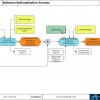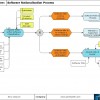Process of the Month – Software Rationalisation Process

Assign a status of Red (to be removed), Amber (can stay for now) and Green (preferred)
Following on from last month’s process of Maintaining a Supported Software Catalogue, we have another process that seemingly appears inconsequential but again, can add great value to the business – and that is the Process of Software Rationalisation.
Having assigned a status of Red (to be removed), Amber (can stay for now) and Green (preferred) we can take an alternative view of our IT estate and compare those software titles on their function. Just how many different types of pdf readers does a company need? (As an example).
The advantage of this process is that it further harmonises software titles within a company, and so better directs finite support resources to a consolidated selection of titles. Such pruning will also cut down on the number of software titles the SAM function has to oversee.
Software Rationalisation Process
Primary Objective
- To compare software titles by classification
Secondary Objectives
- To ensure that this process runs at least once, annually
- To make recommendations for the removal of certain software titles
- To interact with the Supported Software Catalogue Process “status setting” function
Assumptions
- That a field entitled “Classification” exists in the Supported Software Catalogue
- Screenshot A
- Screen Shot B
Function Step Overview
| 1.10 | This process can be kicked off in a number of ways:
|
| 1.20 | Depending on how the process was started at 1.10, this step could involve a series of activities:If step 1 was the sole means of instigating this process, then the SAM Manager will be required to wash the output through his SAM Suite so as to make sense of the raw data provided by the inventory report.If Step 2 was the sole means by which this process was started, then the SAM Manager merely has to take the latest version of the Supported Software Catalogue and filter those titles based on classification.If Steps 1 and 2 are being combined, then the SAM Manager will need to combine and then “de-dupe” the inventory report and the Supported Software Catalogue prior to filtering by classification. This will have the advantage of highlighting those applications that have not been given a classification status. |
1.30 |
The review process within this Rationalisation Process is quite subjective, and one I would spend a great deal of time on setting the parameters for; as this would undoubtedly vary from company to company. The supporting business data I have added for this step includes: Financial/Purchase data, The Technology Roadmap for a given product, The Software titles by classification and the Classification Definition.The SAM Manager and interested parties need to understand what primary and secondary functions are required of that software classification, which titles meet those criteria, how much they cost and whether there is sufficient overlap in the titles before them to consider an outright removal of titles, or perhaps a relegation to Amber in the Supported Software Catalogue. Other, unique business requirements should be factored in here. If any titles are deemed suitable for deletion, then their status is set to Red, which should instigate the Software Removal Process. If any titles have come through with no classification on them (hence the comparison with the inventory report to the Supported Software Catalogue) then those titles can be fed back into the Maintain a Supported Software Catalogue Process for formal status assessment and updating. |
| 1.40 | Having reviewed a title within its classification and decided that it is suitable in all respects to the criteria stipulated in 1.30, the date of the classification review for this title is incremented (typically, by one year) |
As with the “Maintain a Supported Software Catalogue” process, software dependencies are a vital factor to consider in this process. Does the downgrading/removal of a piece of software have a knock-on effect with for other titles? Or perhaps data access?
There is an argument to suggest that this work is done in tandem with the Maintain a Supported Software Catalogue Process, however, that process will typically tackle software titles by vendor, or cost-center (or some equivalent scope) and so vastly reduces the opportunity to assess competing products against one another.
Other Process of the Month Articles:
- Software Re-harvesting Process
- Software Change Mangement Process
- Corporate Governance Process
- Maintain a Supported Software Catalogue
The process kit by Rory Canavan is available from SAMcharter.com
Related articles:
Podcast Episode 10: Doing SAM on the cheap
Land and expand.... what is possible when SAM is done right
Microsoft free server 2008 support – at a cost?
Has inventory data become a commodity? Perhaps it’s time to think again
Mitigate risk and vulnerabilities in your organization
SAM - What can be automated & what needs to stay manual?
- Tags: Process of the Month · rory canavan · SAM · Software Rationalisation
About Rory Canavan
With a technical background in business and systems analysis, Rory has a wide range of first-hand experience advising numerous companies and organisations on the best practices and principles pertaining to software asset management.
This experience has been gained in both military and civil organisations, including the Royal Navy, Compaq, HP, the Federation Against Software Theft (FAST) and several software vendors



I really like this process as it forces the business units once a year to justify if they really need applications. MS Visio, MS Project and many of the Adobe products fall into this.
Within 1.30 I’d recommend organizations check for the impact of upgrade and downgrade rights.
This process is also an ideal opportunity to check for old and new product version running on the same device e.g. SQL 2008 and SQL 2012.
By classification, I assume you mean PDF readers, GIS, photo editor
Hi Paul,
Classification would be defined by function – so yes, PDF readers would be one such function (as an example).